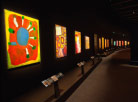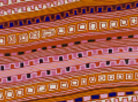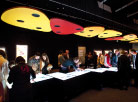Ngurra
Home is like your house, but home to us is like our Country … we’ll always come back to that tribal Country; where old people used to walk around and used to hunt … That’s what we believe. When we die, we become one with the Country. Our spirit goes back. Curtis Taylor, Purnngurr, 2009 – Ngurra means both ‘Country’ and ‘home’ in Western Desert languages and is central to understanding the culture and values of desert people. In the desert Ngurra is usually defined through references to important water sites: physical and spiritual relationships to springs (jila, yinta), rock holes (wanirri) and soaks (jurnu, jumu). Country also defines people’s identities through family connections to places as well as individual spiritual connections before birth and after death. Each of these connections to Country entails specific cultural and ceremonial rights and responsibilities. Today painting country has become part of this ongoing management of Ngurra.
ARTWORK STORY
Kaninjaku, 2008, by Kumpaya Girgaba, Martumili Artists, acrylic on canvas, 124 x 291.5 cm. National Museum of Australia. Kumpaya calls this painting Kaninjaku (Canning Stock Route), but the road is invisible and the canvas is dominated instead by the rhythm of tali, or sandhills. Despite the road’s prominence in colonial history, and its strong influence on the lives of Aboriginal people, here it has been absorbed into the artist’s language and her vision of her Country.






